The MB&F HM8 Mk. 2, And A Look Back At The ‘Driver’s Watch’
“You’re built like a car, oh yeah … ” T-Rex, “Bang A Gong
MB&F has recently announced its latest Horological Machine – the HM8 Mark 2, which is an update to the original HM5 that debuted in 2012.

HM5 had a number of inspirations, two of which were the vintage Amida Digitrend, which launched in 1976, and the Girard-Perregaux Casquette, which was produced from 1976 to 1978. The Digitrend was a mechanical watch (with a fairly basic one-jewel movement) and the Casquette was a quartz LED watch but they both had in common that the time was shown in a window set in the side of the case, facing the wearer.

The use of such a display in a digital watch goes back a little further, to the solar-powered Synchronar watch, launched in 1973, and the side-mounted display in a mechanical watch goes back even further – one of the earliest, if not the earliest, period, was a prototype designed by Gilbert Albert for Patek Philippe, with the movement designed by world-time complication inventor, Louis Cottier.
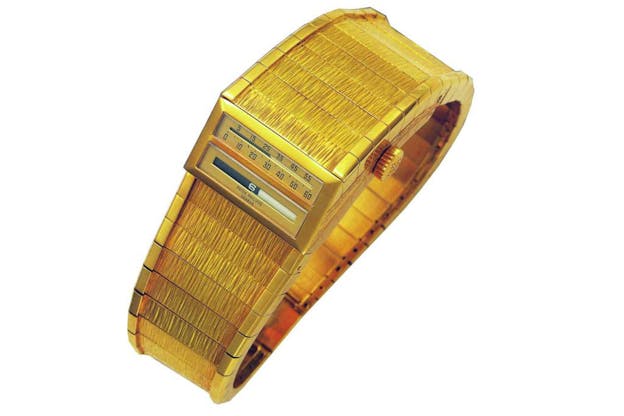
Over the years, we have gotten used to referring to such watches as “driver’s watches” on the theory that they are designed so that the time can be read when the watch is on the wrist, without taking your hand off the steering wheel. Whether this is actually true for any given watch seems to vary from watch to watch. Vintage adds for the Digitrend, at least the ones I’ve seen, don’t mention them being specifically aimed at drivers at all, and the same is true for vintage adds for the Casquette.
The Synchronar had its display on the side for a very good practical reason – the top of the watch was occupied by the photoelectric cells that charged the battery. Whether the Cobra was intended for drivers is anyone’s guess – I suppose there might be hints of its intended audience somewhere in Patek’s archives, but I suspect that all of these watches were driven more by the perceived cool factor of digital displays than anything else. The Cobra at least seems very much inspired by auto dashboards – it’s reminiscent of old linear style speedometers, as seen in the 1961 Buick Electra and 1966 Lincoln Continental, though the Cobra prototype predates both. Similar style speedometers did exist in some luxury cars from the late 1950s, though.
The HM8 And The Case For The Driver’s Watch
However, there are at least some watches with a lateral display that are intended to be driver’s watches – that is to say, to allow the time to be read when your hands are on the steering wheel – which include the Parmigiani Fleurier Type 370 and Type 390 watches. The series of watches from MB&F which began with HM5 and proceeded through the HMX series, up to the present HM8 Mark 2, fall into that category.
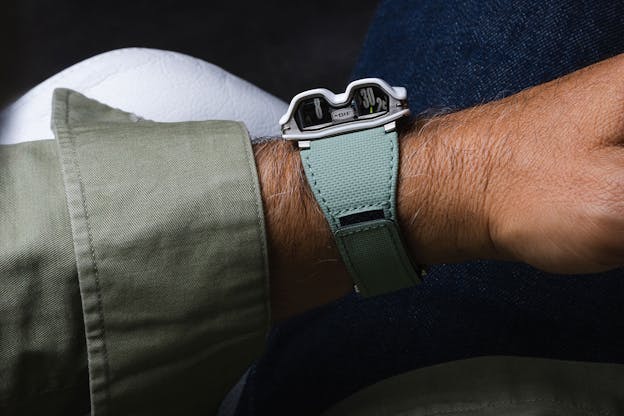
The original HM5 had a louvered case-top window, inspired by the design of the Lamborghini Miura. As with the Parmigiani Type 370, putting the time display on the side of the watch presented some significant engineering challenges.
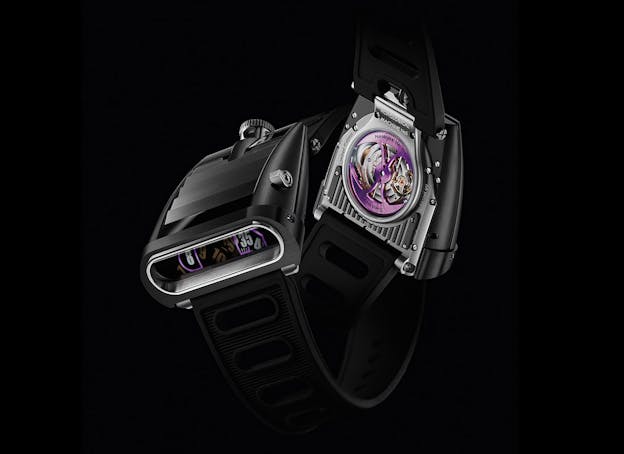
Since the HM5, all subsequent models have basically worked the same way, but with some significant changes to the movement architecture over the years. The Amida Digitrend had two numbered disks lying flat on the movement, and the time could be read off those disks thanks to a plastic prisms set into the case flank (Amida called it the “LRD” for Light Reflective Display). The HM5 used essentially the same basic setup, but where the Amida had two numbered disks side by side, HM5 had two overlapping disks in order to allow the numbers to be larger and more legible. The numbers were also coated with Super-LumiNova and the louvres on the caseback served a practical purpose: they allowed light to get into the case to charge the SNL.
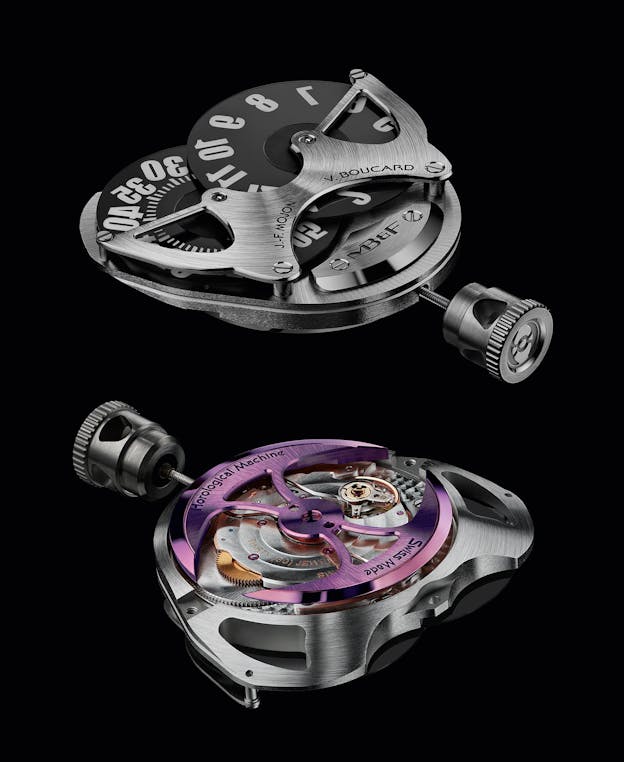
The only drawback to the original design was that the battle axe-shaped oscillating weight for the automatic winding system was on the underside of the movement and therefore not visible when the watch was on the wrist. This was changed for the follow-up HM8, which shifted the winding rotor to the upper side of the case and which had an elaborate roll-bar inspired case design. MB&F called the HM8, the Can-Am.
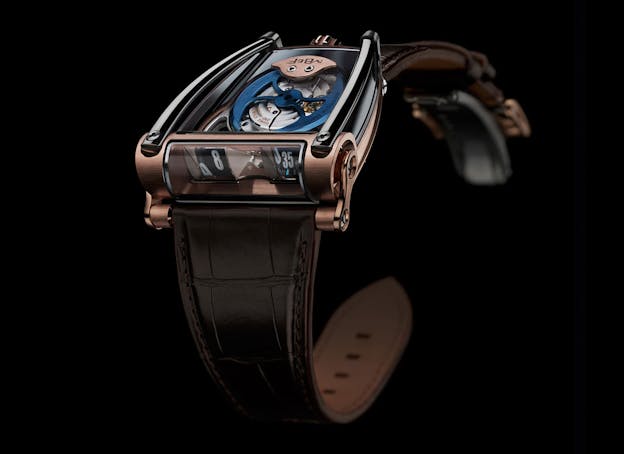
The name, “Can-Am” refers to the now defunct Canadian American Challenge race, which ran from 1967 to 1989. The competing cars were required to follow the FIA Group 7 rules but there were few restrictions and most notably, none at all on engine size or aspiration; both turbochargers and supercharges were allowed. A good example of a Can-Am car was the Porsche 917/30, which was an 1800 pound car with a 1600 horsepower turbocharged engine. I wouldn’t drive one but then, I’m inordinately fond of being alive.
And now to the HM8 Mark 2.
Engine, Chassis, and Coachwork
The relationship between the automotive world and the HM8 Mark 2 is, as they say, more than skin deep.

There are several different major case and movement components. The first is the base automatic winding caliber itself, which is from Girard-Perregaux, of course heavily modified (GP is a long-standing movement partner for MB&F). The gold automatic winding mass is the classic manga-inspired battle-axe shape, which goes all the way back to the very first Horological Machine, HM1, and of course, there’s that double-overlapping-disk complication for the time, and the sapphire prism that reflects the numbers through the window on the side of the case.
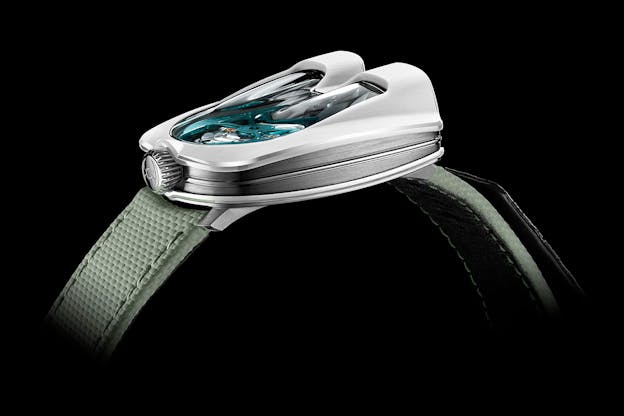
The case is basically a sandwich of titanium on the inside (grade 5 titanium, 47 x 41.5 x 19 mm) and outer “body panels” of CarbonMacrolon, which is a composite material consisting of a polymer mixed with carbon nanotubes. Both the titanium and CarbonMacrolon panels were milled one by one, which for a case shape this complex is an expensive and time-consuming process (titanium is difficult to machine to begin with and the complex case shape doesn’t make life any easier, although decades of working with titanium in the watch and other industries has made milling titanium more or less a known quantity).
The oscillating weight is quite thin as well in order to keep the height and overall mass of the watch down –the thinnest part of the rotor is two-tenths of a millimeter thick.
One of the most time-consuming and expensive components is the sapphire crystal – the double-curve geometry is pretty complicated, almost enough to be considered a kind of complication in its own right, and MB&F says it’s 30 to 40 times more expensive than an industry-standard convex sapphire crystal. (The shape is much more difficult to produce than the crystals on the earlier models). I have no reason to doubt them – a standard sapphire crystal is enough of a predictable product that they can be found in relatively inexpensive watches galore; so much so that they’ve almost become a requirement in anything but the least expensive watch (or a classic Speedmaster – they can have my Hesalite Speedy crystal when they pry it from my cold, dead fingers) but this sort of shape is orders of magnitude more difficult to produce.. The crown is an interesting variation on the typical screw-down crown – you don’t unscrew it to use it; instead, you push it in and turn it 3/4 of a turn to unlock it.

The original HM8 was a showstopper, but it was also not a watch you could imagine actually taking into the possibly rough environment of a high-performance car like the Porsche 917. The first HM8 was a kind of sophisticated kinetic sculpture offering a non-illustrative but spirited homage to certain aspects of automotive history and design. The light weight construction and details like the Velcro-secured fabric strap give the HM8 Mark 2 much more of a track-ready vibe – a sleek, streamlined design that looks ready to put the pedal to the metal.
The HM8 Mark 2: Case, 47 x 41.5 x 19 mm, in titanium and green or white CarbonMacrolon, consisting of 42 components; 30 meter water resistance. Movement, jumping hour and trailing minutes, Girard-Perregaux base, running in 30 jewels at 28,800 vph; 42 hour power reserve. The green CarbonMacrolon version is a limited edition of 33 pieces; price, $78,000. Available now from MB&F.

